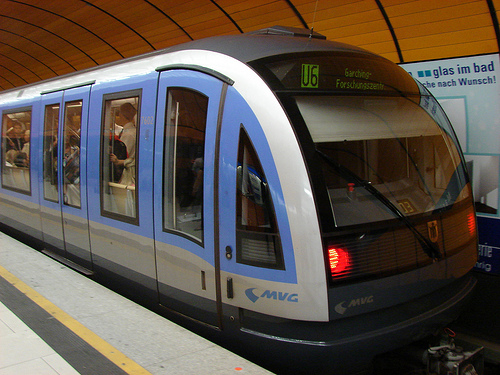Public Transit in Munich, Germany

If you are planning on relocating to Munich, you probably do not need a car, unless you just have an urge to tear up the Autobahn on occasion. The public transit system in this Bavarian city is fast and efficient, like much of Germany. Let it be known that Munich is also very bike-friendly in the inner-city part, as parts of the sidewalks are designated for bikes. It gets cold in Munich so biking is best in the summer.
The system has four parts. There is the U-Bahn, the Untergrund Bahn, or Underground Train; the S-Bahn, the Schnell Bahn, or Fast Train; the Tramway, the Strassenbahn, or tram; and buses. All public transit in Munich is operated under the Muncher Verkehrs und Tarifverbund GmbH. People often refer to this company and all public transit as the MVV, which is pronounced emm-vau-vau in German.
The U-Bahn was first built in 1972 for the Olympics, and has eight lines that go to many of the hot spots and outskirts of Munich. Daytime U-Bahn transit has a fixed schedule where trains come every ten minutes or better. Schedules change after midnight. There are often signs and announcements that tell you when exactly the train will arrive. The main stations in the city center are: Hauptbahnhof, the main railway station, Sendlinger and Marienplatz. Many cultural activities take place around the Olympiapark stop, like big pop concerts. The U-Bahn runs mainly underground.

The S-Bahn trains arrive every 20 minutes in the daytime, and usually every 40 minutes at night. Its network is shaped like a star and not a circle. All of the trains have one communal tunnel between Hauptbahnhof and Ostbahnhof, and the trains go in all directions and don’t meet again. This makes it not as efficient as the U-Bahn, or many other transit systems. The S-Bahn also has older trains that don’t have climate control, but Munich has been trying to replace them with new trains. However, if you want to relieve your stress from this system, there is a beer garden within walking distance from almost all the stops.
The trams of Munich exist in the inner-city and have many different stops. They are good if you are only in Munich for a short amount of time and want to see the city. Trams only stop if you push a button to request a stop, so be ready for that.
The buses of Munich are good for getting around the outskirts. They usually arrive every 20 minutes. The drivers will often not speak other languages than German so it is a good idea to know where you are going!
Tickets for public transit in Munich often operate on the honors system, where people go in disguise dressed as ordinary passengers, and pull out an inspector sign out of nowhere.
Click here for a train map.

The Europe-ADAC study rated the Munich city transport #1 among 23 other candidates, reported the Munich Times http://www.themunichtimes.com. Passengers rated fast pace with which buses and trains traverse the city and comfort.
I thought it was a good system when I went there!